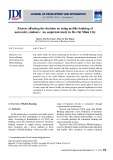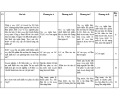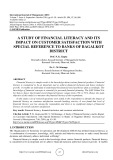
http://www.iaeme.com/IJM/index.asp 1 editor@iaeme.com
International Journal of Management (IJM)
Volume 10, Issue 4, July-August 2019, pp.1–8, Article ID: IJM_10_04_001
Available online at http://www.iaeme.com/ijm/issues.asp?JType=IJM&VType=10&IType=4
Journal Impact Factor (2019): 9.6780 (Calculated by GISI) www.jifactor.com
ISSN Print: 0976-6502 and ISSN Online: 0976-6510
© IAEME Publication
CUSTOMER PERCEPTION TOWARDS
PAYMENT BANK: A CASE STUDY OF
CUTTACK CITY
Dr. Kishore Kumar Das
Associate Professor & Head – Department of Business Administration,
Ravenshaw University, Cuttack, India
Rupsa Mahapatra*
Rupsa Mahapatra, Research Scholar in Management,
Ravenshaw University, Cuttack, India
*Corresponding Author
ABSTRACT
A new model of banks conceptualized by the Reserve Bank of India (RBI) is
popularly known as Payment Bank. As these banks cannot issue loans and credit cards,
but both current and savings accounts can be operated by such banks. Money is the life
blood of every economy. Now-a-days cash transactions are much simpler due to the
popularization of internet, smart phones and other digital technologies. Therefore most
of the transactions were cashless and if these practices will continue as it is then in
future physical form of currencies will no longer be a king. Privacy, security and
convenience are the factors which influence the users while using the facility of payment
banks. The last decade has seen tremendous growth in use of internet and mobile phone
in India. Increasing use of internet, mobile penetration and government initiative such
as Digital India are acting as catalyst which leads to exponential growth in use of digital
payment. But still many people are there who were not ready to accept this system of
banking as they have a thinking of being cheated. The current paper will help to identify
the customer perception towards payment bank.
Key word: banks, internet, digital, technologies, mobile, cashless, transactions.
Cite this Article: Dr. Kishore Kumar Das and Rupsa Mahapatra, Customer Perception
Towards Payment Bank: A Case Study of Cuttack City, International Journal of
Management, 10 (4), 2019, pp. 1–8.
http://www.iaeme.com/IJM/issues.asp?JType=IJM&VType=10&IType=4
1. INTRODUCTION
Payment banks are the latest initiative from the Reserve Bank of India with the primary motive
to promote digital, paperless and cashless banking in our nation. Traditional banks can do
everything payment banks can, but due to their structures and business priorities they may be
unable to cater to certain segments and geographies. For instance, while it is impossible for a

Dr. Kishore Kumar Das and Rupsa Mahapatra
http://www.iaeme.com/IJM/index.asp 2 editor@iaeme.com
bank to open branches in every village across the country, payment banks can fill this gap
through the use of mobile phones. The adoption of internet banking by the banks customer is
important since the costs per transaction are even lower than those of an ATM. Besides, it does
not require physical infrastructure. Most banks today have facilities to enable internet banking
customers to pay utility bills online. Internet banking has not caught the fancy of majority of
customers. Small percentage that avail the facility, even makes a difference to the overall costs
for the banks. Indian banking is witnessing a dynamic phase due to the continuous change in
polices of RBI and the government of India. In 2015, RBI issued licenses for the first time to
11 entities to start payment banks in order to improve banking penetration. Of these 11, three
entities have started their payment banks and are trying to influence customers through
technology driven services.
There are two main ways in which payment banks are different from traditional banks.
Firstly they can accept deposits of only up to Rs. 1lakh, and they cannot lend. Since payment
banks are not allowed to lend , they make their profits by selling third party products. Secondly
while payment banks themselves can not offer certain services to customers, they can always
partner with traditional banks for providing loans and selling investment products.
2. DEVELOPMENT OF PAYMENT BANKS
Today’s world and its generations are very smart. They always try to do more work in less time.
India is one of the countries which consist of major user of smartphones and mobile
applications. These smartphones, internet facilities, mobile applications are the key drivers for
cashless society. Mobile devices have transformed the entire world by a click of a button
anything from purchase, payment or transfer can take place. With the increase in the availability
of 4G networks across the country, the digital payments becoming faster without any
inconvenience. On 23 September 2013 , committe on Comprehensive Financial Services for
Small businesses and Low Income Households headed by Nachiket Mor, was formed by the
RBI. On 7 January 2014, the Nachiket Mor Committee submitted its final report. Among its
various recommendations, it recommened the formation of a new category of bank called
Payments Bank. On 17 July 2014, the RBI released the draft guidelines for Payment Banks,
seeking comments for interested entities and the general public. On 27th November , RBI
released the final guidelines for payment banks.
In February 2015, RBI released the list of entities which had applied for a Payments Bank
licence.There were 41 applications. It was also announced that an external advisory committee
(EAC) headed by Nachiket Mor would evaluate the licence applications.On February 2015 ,
during the presentation of Budget it was announced that India Post will use large network to
run Payment Bank. The external advisory committee headed by Nachiket Mor submitted its
findings on 6 july 2015. The applicant entities were examined for their financial track records
and governance issues. On 19 August 2015, the Reserve Bank of India gave “in-principle”
licences to eleven entities to lunch Payment Banks.The “in – principle” licence was valid for
18 months within which the entities must fulfill the requirements and they were not allowed to
engage in banking activities within the period. The RBI will grant full licences under section
22 of The Baanking Regulation Act,1949,after it is satisfied that the conditions have been
fulfilled. There are various methods for digital payments such as mobile banking, internet
banking, banking cards, mobile wallets, etc. In recent time mobile wallets, UPI (Unified
Payment Interface) applications are being popularized. Some of the popularly used transaction
apps are Paytm, Tez, Paypal, PhonePe, freecharge, rupay, BHIM, Aadhaar pay, and even every
bank has developed their own banking apps. There are social media companies such as amazon,
facebook and electronic currencies like Bitcoins seeking to enter the payment market.
Consumers believe that the cashless society is more transparent and convenient. But there are

Customer Perception Towards Payment Bank: A Case Study of Cuttack City
http://www.iaeme.com/IJM/index.asp 3 editor@iaeme.com
also some disadvantages associated with payment bank services like barriers in digital payments
such as technical issues, lack of clarity, consumers’ acceptance level, enough bank balance, etc.
Therefore keeping the eyes on consumer satisfaction level day by day these issues are
minimising by the incraesing its efficiency and user-friendly utilization.
3. STATEMENT OF THE PROBLEM
With the aim of expanding banking services in the country, RBI thrust responsibility on the
Nachiket Mor Committee to explore and make recommendations for the development of a
special category of banks to provide comprehensive financial services to small businesses and
low income families. One such recommendation has been the creation of payment banks
primarily to facilitate financial inclusion. Many traditional banks does not open branches in
extreme rural areas in India. Payment banks go where traditional banks do not. It is assumed
that the rural people will welcome the system due to its advantages. Here the concept and
players are relatively new, however only the positive aspects are focused upon. The negetive
aspect which may arise due to increasing competition or sour attitute of traditional banks due
to missing out on a new avenue or business opportunity has been looked over. Credit restrictions
imposed by the RBI on payment banks restricts the growth and this being a relatively new sector
not much research is conducted on how exactly the growth trend or the strategy of payment
banks would be due to lack of examples. Therefore a full scale research can be conducted in
this aspect to know the perception of customers towards payment banks. The people still might
not be ready to adopt this system as demonitization has just taken place which in some cases
may have in convenienced the masses. To expect the masses again to adopt a new system of
functioning in a relatively short span may be along shot and could effectively backfire. In this
context, the presend study is highly essential.
4. LITERATURE REVIEW
Dahlberg T, Mallat N, Oorni A (2003) concluded that Security and privacy were the major
concerns for the consumers which affect the adoption of digital payment solutions.
Soman D (2001) Soman D (2003) Srivastava J, Raghubir P (2008) analysed that Growth
in technology has opened many modes of payments through which consumers can do
transactions which are more convenient, accessible and acceptable.
Mallat N (2004) studied consumer adoption of mobile payments in Finland. Study found
that mobile payment is dynamic and its adoption depends on lack of other payments methods
and certain situational factors.
Dewan SG, Chen LD (2005) illustrated in their research paper that consumers have an
inclination towards mobile payment apps usage. There has been many studies conducted in past
on mobile payment application to find consumer interest and they found consumer has positive
inclination for the same.
Dahlberg T, Mallat N, Ondrus J, Zmijewska[2008] explained in their research, A Doing
payments via mobile phones has been in use for many years and is now set to explode. Also
mobiles are increasingly being used by consumers for making payments. A comprehensive
model ‘Payment Mode Influencing Consumer Purchase Model’ was proposed by Braga and
Mazzon. This model considered factors such as temporal orientation and separation, self-
control and pain of payment constructs for digital wallet as a new payment mode. Consumer
perspective of mobile payments and mobile payment technologies are two most important
factors of mobile payments research.
Shin and Ziderman [2009] tested a comprehensive model of consumer acceptance in the
context of mobile payment. It used the unified theory of acceptance and use of technology

Dr. Kishore Kumar Das and Rupsa Mahapatra
http://www.iaeme.com/IJM/index.asp 4 editor@iaeme.com
(UTAUT) model with constructs of security, trust, social influence, and self-efficacy. The
model confirmed the classical role of technology acceptance factors (i.e., perceived to users’
attitude), the results also showed that users’ attitudes and intentions are influenced by perceived
security and trust. In the extended model, the moderating effects of demographics on the
relations among the variables were found to be significant. Digital wallets offer the consumers
the convenience of payments without swiping their debit or credit cards. Instant Cash
availability and renders seamless mobility is also a unique feature of these digital apps, for
instance the balance in your Paytm wallet can be very easily transferred to your bank account
as and when you want.
Bamasak [2011] carried out study in Saudi Arabia found that there is a bright future for m-
payment. Security of mobile payment transactions and the unauthorized use of mobile phones
to make a payment were found to be of great concerns to the mobile phone users.
Liu S, Zhuo Y, Soman D, Zhao M (2012) Offering various benefits such as flexi payment
digital wallet brands are providing extra convenience to consumers. Digital wallet payments
bring extra convenience to shoppers by offering flexible payment additions and accelerating
exchanges.
Padashetty S, Kishore KS (2013) pointed in their study the factors such as perceived ease
of use, expressiveness and trust affect adoption of digital wallet as payment method. These
factors are termed as facilitators and plays crucial role in adoption of digital payment solution.
Doan [2014] illustrated the adoption of mobile wallet among consumers in Finland as only
at the beginning stages of the Innovation-Decision Process. “Digital Wallet “has become a part
of consumers which are nothing but smart phones which can function as leather wallets.
Wamuyu PK (2014) found that Digital wallet offered many benefits while transferring
money such as convenience, security and affordability.
Rathore HS (2016) found Major factor in adoption of digital wallet is convenience in
buying products online without physically going from one location to another location.
Taheam K, Sharma R, Goswami S (2016) analysed Usage of digital wallet among youth
in the state of Punjab was found to be associated with societal influence and usefulness,
controllability and security, and need for performance enhancement. Premium pricing,
complexity, a lack of critical mass, and perceived risks are the barriers to adoption of digital
payment systems.
5. RESEARCH GAP
The review of literature shows number of works undertaken over the period to study the
perceptions of the prospective payment bank users still there is lot of scope for research for the
present sample and period.
6. OBJECTIVE OF THE STUDY
To know the perception of customers towards payment bank.
To make a comparative study on the users of payment bank irrespective of their age, gender,
educational background and monthly income.
7. RESEARCH METHODOLOGY
The concept of payment banks is quite new in India. The purpose of our research is to analyse
the perception of customers towards payment bank. The primary data for the study was
collected through distributing structured questionnaires among the users. The sample size is
limited to 110 respondents. The study was conducted based on the convenient sampling
technique. The data collected was analyzed to estimate its trend across the variables.

Customer Perception Towards Payment Bank: A Case Study of Cuttack City
http://www.iaeme.com/IJM/index.asp 5 editor@iaeme.com
8. ANALYSIS AND DISCUSSION
8.1. Study of Gender profile
The present study is based on the samples of 110 respondents of Cuttack city. The table-1 and
the corresponding figure -1 reflects that the total samples comprising 71percent male where as
29 percent are female. This is found in the primary data which are collected by random
sampling. The composition shows more male members are using cash less system or payment
bank method to settle their commercial transactions.
Table 1 Study of Gender profile of samples
Profile
Frequency
Percentage
Male
78
70.91
Female
32
29.09
Total
110
100.00
Sources: Compiled from Collected data
Figure 1 Study of Gender profile of sample
Sources: Compiled from Collected data
8.2. Study of Age profile
The present study about the age profile of the sample as per Table-2 and Figure-2 shows that
there are 35.45 percent user of payment banks are belongs to the age group below 30 years
where as 39.10 percent users are belongs to the age group of 31-40 years. This reflects that the
majority of users are in the age group of 31-40 years. If we consider the age group up to 40
years then about 74.55 percent which is 3/4th of the total users are belongs to this group. The
lowest users of payment bank belong to the age group of above 50 years which is about 10
percent. This indicates the insecurity as regards use of payment bank increases with increasing
age. Table 2 Study of Age profile of samples
Age
Frequency
percentage
Below 30 years
39
35.45
31-40 years
43
39.10
41-50 years
17
15.45
Above 50 years
11
10.00
Total
110
100
Sources: Compiled from Collected data
frequency
Male
Female









![Vay vốn Agribank: Điều kiện và thủ tục [mới nhất]](https://cdn.tailieu.vn/images/document/thumbnail/2020/20200720/mami89/135x160/7951595232152.jpg)
















